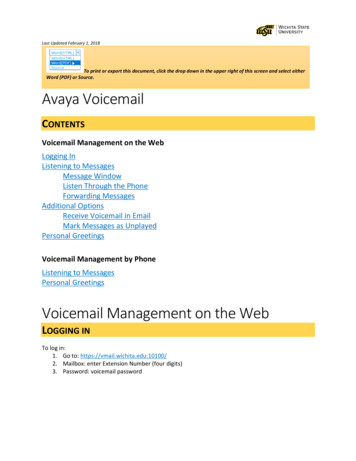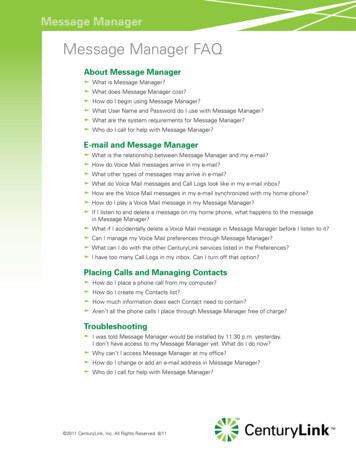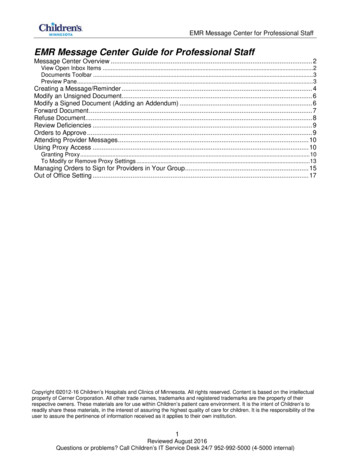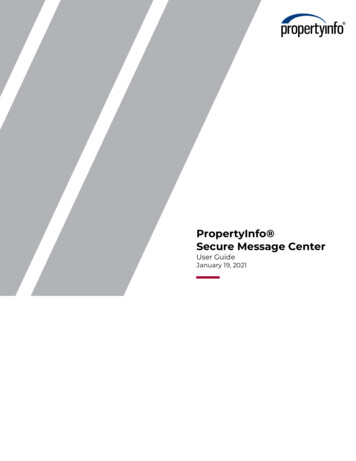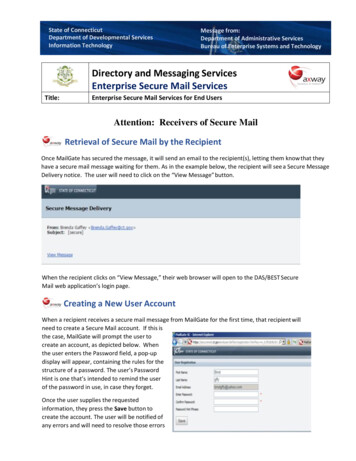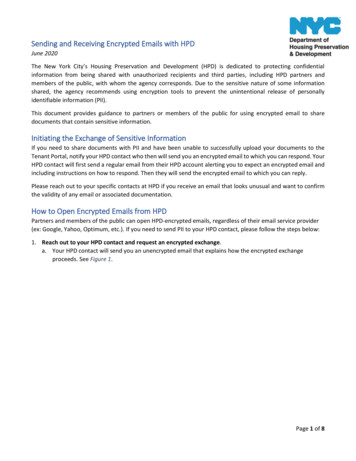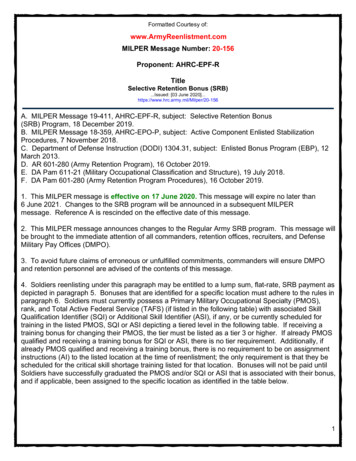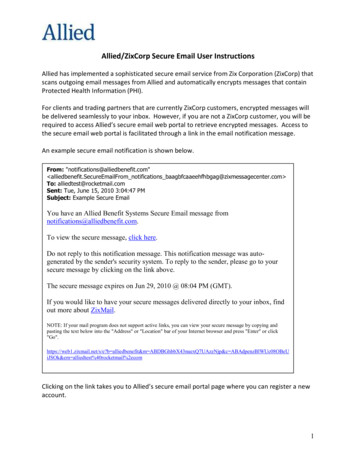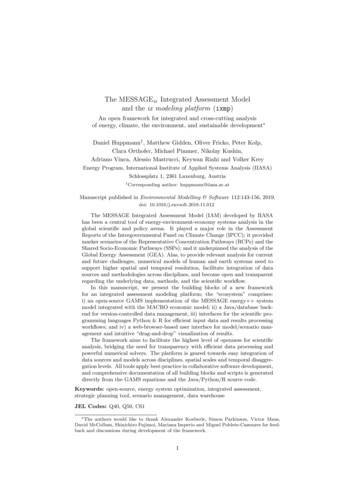
Transcription
The MESSAGEix Integrated Assessment Modeland the ix modeling platform (ixmp)An open framework for integrated and cross-cutting analysisof energy, climate, the environment, and sustainable development Daniel Huppmann† , Matthew Gidden, Oliver Fricko, Peter Kolp,Clara Orthofer, Michael Pimmer, Nikolay Kushin,Adriano Vinca, Alessio Mastrucci, Keywan Riahi and Volker KreyEnergy Program, International Institute of Applied Systems Analysis (IIASA)Schlossplatz 1, 2361 Laxenburg, Austria† Correspondingauthor: huppmann@iiasa.ac.atManuscript published in Environmental Modelling & Software 112:143-156, 2019.doi: 10.1016/j.envsoft.2018.11.012The MESSAGE Integrated Assessment Model (IAM) developed by IIASAhas been a central tool of energy-environment-economy systems analysis in theglobal scientific and policy arena. It played a major role in the AssessmentReports of the Intergovernmental Panel on Climate Change (IPCC); it providedmarker scenarios of the Representative Concentration Pathways (RCPs) and theShared Socio-Economic Pathways (SSPs); and it underpinned the analysis of theGlobal Energy Assessment (GEA). Alas, to provide relevant analysis for currentand future challenges, numerical models of human and earth systems need tosupport higher spatial and temporal resolution, facilitate integration of datasources and methodologies across disciplines, and become open and transparentregarding the underlying data, methods, and the scientific workflow.In this manuscript, we present the building blocks of a new frameworkfor an integrated assessment modeling platform; the “ecosystem” comprises:i) an open-source GAMS implementation of the MESSAGE energy systemmodel integrated with the MACRO economic model; ii) a Java/database backend for version-controlled data management, iii) interfaces for the scientific programming languages Python & R for efficient input data and results processingworkflows; and iv) a web-browser-based user interface for model/scenario management and intuitive “drag-and-drop” visualization of results.The framework aims to facilitate the highest level of openness for scientificanalysis, bridging the need for transparency with efficient data processing andpowerful numerical solvers. The platform is geared towards easy integration ofdata sources and models across disciplines, spatial scales and temporal disaggregation levels. All tools apply best-practice in collaborative software development,and comprehensive documentation of all building blocks and scripts is generateddirectly from the GAMS equations and the Java/Python/R source code.Keywords: open-source, energy system optimization, integrated assessment,strategic planning tool, scenario management, data warehouseJEL Codes: Q40, Q50, C61 Theauthors would like to thank Alexander Koeberle, Simon Parkinson, Victor Maus,David McCollum, Shinichiro Fujimoi, Mariana Imperio and Miguel Poblete-Cazenave for feedback and discussions during development of the framework.1
1IntroductionNumerical tools for energy-economic-engineering-environment (E4) systems and ”Integrated Assessment Models” (IAM) are a vital component in the analysis of energysystem transitions in the context of climate change mitigation and sustainable socioeconomic development. These tools are applied to advance scientific understandingof the underlying dynamics, and to evaluate the various policy options to mitigateclimate change, safeguard the environment, and ensure universal access to clean andreliable energy (e.g., Riahi et al., 2017; Edenhofer et al., 2014; Riahi et al., 2012).It is an often-repeated mantra of applied research that “modeling is for insights,not numbers” (cf. Huntington et al., 1982). Indeed, numerical optimization and simulation tools are well suited to illustrate the interdependencies within and betweenthe complex human and earth systems, highlighting interactions and feedback effectsthat may seem counter-intuitive at first glance. In addition to qualitative insights, numerical quantifications of pathways or storylines serve a useful role in illustrating theunderlying narrative. Even with the caveat that specific parameters are not knownwith the desired level of confidence, parametrizing a model requires the researcherto carefully and deliberately choose values that are a best estimate at the time ofconducting the analysis (Paltsev, 2017; Weyant, 2014).1.1Three paradigm shifts of systems modelingNumerical models have long been a cornerstone of the dialogue between the scientificcommunity and the global policy arena. Alas, there are numerous fundamental shiftswith regard to the analysis of energy systems and the environment in a context ofsustainable development and climate change. These new requirements are drivingdevelopments of numerical models for human and earth systems (e.g., Pfenninger et al.,2014).Below, we highlight three of these shifts to illustrate how the framework introducedin this manuscript can facilitate a more effective analysis to ensure that numericalmodeling can provide adequate answers to current and future challenges.Increasing complexityFirst, the systems that numerical tools are expected to describe are exhibiting everincreasing complexity. This can be illustrated in the electricity sector, where variablerenewable energy sources are requiring a paradigm shift in the approach to energyinvestment, planning and market design (Pietzcker et al., 2017; Johnson et al., 2016;Ueckerdt et al., 2015). Furthermore, the quest for a better representation of complexinteractions goes beyond the technical-engineering aspects and into the realm of socialsciences. For example, Rao et al. (2014) explore the interdependence between emissions and poverty eradication, and Sohail et al. (2017) analyze synergies and trade-offsbetween energy-efficient urbanization and health. While a broad-brush approach centered on an assumption of rising incomes and associated energy demand growth mayimply ever-increasing emissions, a more focused analysis centered on human development and decent living can identify opportunities to satisfy basic needs globallywithout exceeding available resources.Nexus issues and interaction across sectorsSecond, improved awareness of nexus issues and interaction across sectors draws attention to methodological limitations and overly-constraining model boundaries. Furthermore, considerations of cross-sectoral impacts may render options or solution strategies2
infeasible that seemed to be the preferred choice in a one-dimensional, narrowly focused analysis (cf. Keairns et al., 2016).While the first challenge can be overcome by developing models that are moredetailed with regard to spatial and temporal resolution, adequately addressing nexusissues usually requires linking models from various disciplines including engineering,geophysics and earth sciences, as well as economics and the social sciences. Thesescientific fields usually apply different methodologies, making the consistent communication of assumptions and an effective integration between them a non-trivial matter(Mantzos et al., 2016).A further consequence of these considerations is a paradigm shift away from monolithic models towards a bifurcation of model development: on the one hand is a modular design of frameworks, which provides flexibility and facilitates updating both theinput data and the mathematical formulation or structure underpinning individualmodules of ever more complex assessment tools. The EIA’s National Energy Modeling System (NEMS) is a case in point.1The alternative to such groups of ”soft-linked” in-depth sectoral models is thedevelopment of a deliberately stylized representation of drivers and impacts. By virtueof nimble and computationally efficient design, such models can be run much moreoften than complex modular frameworks. In this way, such stylized models can providevaluable first-order approximations of interdependencies and trade-offs. The reducedcomplexity climate model MAGICC (Meinshausen et al., 2011) is an example of thelatter approach. It is frequently coupled with integrated assessment models to evaluatetemperature implications of energy systems transition and climate change mitigationscenarios.Transparency, reproducibility, and intelligibilityThe third driver for a new modeling paradigm is the need for transparency, reproducibility, and intelligibility of scientific analysis – both with regard to the methodology as well as the underlying data and assumptions. IAMs in particular have comeunder scrutiny for their “black-box” nature and the perceived ad-hoc approach to important aspects (Rosen and Guenther, 2015; Pindyck, 2013; DeCarolis et al., 2012).More importantly, it is a fundamental caveat of long-term, numerical energy-economymodels that they cannot be validated against real-world results – at least not in thesense of validation applied in climate research or other natural sciences tools based oninvariant physical principles (Wilson et al., 2017a).In response to increasing focus on validation and critical assessment, policymakers, funding agencies and the scientific community have increased their expectationsof openness, reproducibility and standardization of model-based policy analysis (Pfenninger et al., 2017; Cao et al., 2016). Furthermore, the development of open-sourcesoftware and tools for effective collaboration has revolutionized many fields of businessand academic analysis over the past decades. This new paradigm of openness has alsoreached the energy and climate change research community, initiating numerous newprojects and initiatives (e.g., Morrison, 2018; Pfenninger et al., 2018).The need for a new kind of modeling frameworkTo effectively tackle the issues surrounding transparency, reproducibility and intelligibility, a paradigm shift is required that goes beyond implementing marginal extensionsin established modeling platforms like MESSAGE (see next section), TIMES (Loulouand Labriet, 2008), or OSeMOSYS (Howells et al., 2011). Instead, a new infrastructure is required to seamlessly integrate scientific workflows, data processing and policy1 Seethe documentation of NEMS at www.eia.gov/outlooks/aeo/nems/documentation.3
analysis across different disciplines and spatial scales. This modeling system mustdraw on best-practice in collaborative software development and apply the best methods for different parts of the “scientific supply chain”, ranging from data collectionvia pre-processing and numerical computation to a comprehensive toolbox for analysisand evaluation of the results.1.2The history of the MESSAGE modelThe Model for Energy Supply Systems And their General Environmental impact (MESSAGE) is a process-based integrated assessment model ; it allows for a detailed representation of the technical-engineering, socio-economic, and biophysical processes inenergy and land-use systems. It is a linear/mixed integer optimization model, aiming to satisfy a given demand level at least cost, with optional coupling to a stylizedmacro-economic model to describe the feedback of end-use prices on demand for energyservices.The model has been developed at IIASA over the last four decades (Schrattenholzer, 1981). While the first version focused on the supply-side of fossil resources andnuclear energy, subsequent work extended the mathematical formulation and the scopeof the full energy system representation (Messner and Strubegger, 1995). Pioneeringwork on endogenizing technological change into an energy system model was donewith MESSAGE (Messner, 1997). Further, the least-cost energy system optimizationmodel was linked to the general-economy model MACRO to incorporate feedback fromend-use prices on energy demand and substitution between different sectors (Messnerand Schrattenholzer, 2000). A stochastic version was developed to compare alternative approaches to risk modeling and to analyze the impact of hedging on transitionpathways (Krey and Riahi, 2013; Messner et al., 1996)MESSAGE was frequently applied to pertinent questions at the interface betweenscience and policy in the context of energy system transitions and environmental questions. In the past decade alone, the MESSAGE model was used in a number of highlyvisible projects: it underpinned a substantial part of the Global Energy Assessment(GEA, Riahi et al., 2012); it contributed one of the marker scenarios for the Representative Concentration Pathways (RCP, Riahi et al., 2011); and it was used as amarker scenario for the Shared Socio-economic Pathways (SSP, Fricko et al., 2017).Scenarios developed using the MESSAGE model were also included in the analysis ofthe Intergovernmental Panel on Climate Change (IPCC, Edenhofer et al., 2014, andearlier Assessment Reports).Over the past years, the global version of the MESSAGE model has been extendedto include many drivers relevant for the analysis of energy supply and demand: Raoand Riahi (2006) analyzed the role of multiple non-CO2 greenhouse gases and implemented a detailed accounting of pollutants. Sullivan et al. (2013) and Johnson et al.(2016) developed methodologies to specifically represent the challenges presented byvariable renewable electricity sources on the power system. Fricko et al. (2017) developed an endogenous integration with the land-use model GLOBIOM (Havlı́k et al.,2014) and the forestry model G4M (Kindermann et al., 2008).Cameron et al. (2016) and Ekholm et al. (2010) extended MESSAGE to specificallyincorporate the analysis of universal access to clean energy, which is a particularpublic health concern among the poor population in South East Asia. Lehtveer et al.(2015) and McCollum et al. (2013) embedded MESSAGE in a multi-criteria assessmentframework to analyze the trade-off and synergies between different objectives includingenergy security, climate change mitigation and reduction of air pollution.All of the studies listed above are based on the global MESSAGE implementationdeveloped at IIASA, where the world is represented by eleven regions. The documentation of this MESSAGE version, including the integration with the GLOBIOMand MACRO models, is available at data.ene.iiasa.ac.at/message-globiom/ (Krey4
et al., 2016); this documentation page will be updated regularly to incorporate newmodel developments and scientific publications.MESSAGE at the International Atomic Energy AgencyBeyond the applications of MESSAGE at IIASA working on the science-policy interface, the matrix generator underpinning the MESSAGE model until now was alsodistributed by the International Atomic Energy Agency (IAEA) to its member countries for strategic energy planning purposes since 2000 (IAEA, 2016). It continues tobe used actively in ca. 30 countries, and numerous model applications and publications at the national level have resulted from that collaboration, for example in Brazil(de Lucena et al., 2010; Herreras Martı́nez et al., 2015), Lithuania (Streimikiene andBalezentis, 2013) and Chile (Watts and Martinez, 2012).1.3An evaluation of the MESSAGE modelWilson et al. (2017a) define five criteria according to which numerical systems assessment tools should be evaluated for their adequacy to yield policy-relevant insights:appropriateness for the research question; interpretability of the underlying conceptand methodology as well as the results; verifiability and detailed documentation ofthe model code including both the mathematics and the scientific workflow (datamanagement and post-processing); credibility of the derived insights and policy recommendations; and usefulness by advancing understanding of challenges and policyoptions.Similar criteria for evaluation are, for example, discussed by Schwanitz (2013),stressing in particular that model evaluation must be treated as a continuous process, rather than a one-off exercise. Furthermore, comprehensive documentation andtransparency are identified as paramount for any meaningful evaluation.Jakeman et al. (2006) make a similar case, structured around 10 iterative stepsto consider during model development, parametrization and evaluation/testing. Theauthors emphasize the need to start with a clear conceptualization of the system tobe modeled and continue with a critical evaluation of the model structure and datacollection techniques. Then, gaining an understanding of parameter uncertainty areas important as identifying criteria for verification and testing. Most importantly,assumptions and modeling choices made early in the development process need to becritically reviewed regularly.Principles for the development and assessment of energy-system optimization models in particular (i.e., frameworks like MESSAGE) are presented by DeCarolis et al.(2017). They discuss in detail the many dimensions in which such models can beextended, including endogenous learning, price-elastic demand, and uncertainty. Theauthors highlight potential trade-offs between more advanced approaches and computational complexity, and explicitly caution against including too much detail whenthis is not pertinent for the research question at hand.Given the extensive track record of the MESSAGE model, the framework hasbuilt up substantial credibility and has proven to be useful in the evaluation of systems transition pathways. Most of the extensions for energy-systems models discussedby DeCarolis et al. (2017) have been implemented in MESSAGE at some point, aslaid out in the previous section. Where these extensions involved substantial additional computational burden, they have been used only in stand-alone branches; otherdevelopments were integrated into the main version. The versatility of MESSAGEis furthermore illustrated by the many developments beyond the energy sector addedover the years, indicating that the combination of a least-cost systems optimizationapproach with a general-economy model is an appropriate avenue for many pertinentresearch questions at the science-policy interface.5
The aspects in which the existing MESSAGE framework was lacking are relatedto transparency, interpretability and verifiability. The model code (a compiled matrixgenerator written in C) and the post-processor (Strubegger, 1984), while being continuously updated and improved over the years, do not meet software development standards of today. A flexible formulation of “user-defined relations” (linear constraints tothe optimization problem) allowed to implement a broad range of mathematical features like share-constraints or bounds on aggregate activities across technologies – butthe implementation did not always provide the required versatility or ensure straightforward interpretability of the model structure. Over the years, user-defined relationswere used for so many purposes in the global MESSAGE model that documentationof constraints and parameter values became a burden.Alas, the most significant drawback was a multi-layered, custom-built text-fileformat for input data, model output and processed results. This made it relativelycumbersome to keep track of data changes and hampered efficient data pre- and postprocessing routines or integration with scientific programming workflows.1.4Goals for developing a new systems modeling frameworkWhen setting out to work on a new platform based on the existing MESSAGE model,our aim was building on the proven track record – while developing a framework thatspecifically replaced those parts of the system limiting effective modeling. In particular, the goal was to allow more efficient scientific workflows and direct integration withexternal data sources and other models or tools. A second aim was providing an implementation where users could easily add new equations and parameters for specific usecases like representation of renewables or emissions accounting, rather than resortingto the generic “one-size-fits-all” implementation of constraints using the user-definedrelations in the previous MESSAGE framework.Framing our ambition in terms of the threeparadigm shifts stated earlier, both the underlying mathematical formulation and the data processing environment should be optimized towardsa comprehensive representation of complex systems. In particular, this includes native handlingof spatially explicit data sets or simple development of models that operate across different spatial and temporal scales.Regarding the integration of models acrosssectors, methodologies and disciplines, the underlying principles of the platform anticipate thatsuch linkages will be of paramount importancefor any relevant analysis over the next years. Theframework provides well-defined interfaces to faFigure 1: Key features ofthe ix modeling platformcilitate the exchange of input data and model results across disciplines and methodologies.To this end, all components apart from the actual equations of the MESSAGEix MACRO model written in GAMS (see below) are implemented in a way that theplatform can be used as a data warehouse and processing facility for any numericalmodel. The database architecture, the browser-based user interface, and the interfacesto the scientific programming languages Python and R are agnostic regarding the typeof mathematical program or data.Last, but not least, the platform should support best-practice collaborative research and facilitate transparency, interpretability, and verifiability. There are, as aminimum, three dimensions to the quest for openness in this context (cf. Pfenningeret al., 2017): The mathematical formulation and the implementation in a numerical6
programming language must be easily accessible. Furthermore, it should be simpleto extend the structure or add model features (e.g., introduce new types of equations) even for non-expert users. Next, the underlying data and model results mustbe accessible in an intelligible format. Finally, the scientific workflows used for datapre-processing, model execution, and analysis of results must be implemented in a waythat allows scrutiny and external evaluation.As a consequence of these considerations, the platform was structured around fourkey features illustrated in Figure 1. The ultimate goal, as elaborated previously, wasto develop a framework to improve transparency and effectiveness of policy-relevantmodeling. The individual building blocks are listed below and described in detail inthe following sections. The MESSAGEix -MACRO mathematical model – A least-cost systems optimization program integrated with a stylized general-economy model implementedin GAMS and published under an open-source license (Section 4); A Java back-end linked to a powerful database architecture for scenario datamanagement, incorporating comprehensive version control (Section 2.3); Interfaces to the scientific programming languages Python and R for data processing and implementation of workflows for model integration (Section 2.5); A REST API for standardized data exchange using web services (Section 2.6); A user interface accessible via any web browser for model/scenario managementand data/results analysis, offering state-of-the-art features like Pivot table visualization and easy access to full data version control features including anitem-by-item change log (Section 3).In line with the goal of transparency and accessibility, the GAMS equations and theJava, Python and R interfaces are implemented with auto-documentation functionality: html pages are generated automatically with detailed documentation of themathematical formulation for MESSAGEix and MACRO, as well as a comprehensivemanual of all functions implemented in the programming interfaces. All these documentation pages are generated directly from the model code, in line with best practiceof software development, and they can be viewed with any current web browser.We envision that the ix modeling platform and the MESSAGEix model will be frequently upgraded to incorporate new features and support the integration with othermodels. Therefore, the following sections do not provide a comprehensive documentation of all features. Instead, this manuscript provides an overview of the guidingprinciples and key components, and we refer to the comprehensive documentationavailable at MESSAGEix.iiasa.ac.at and the source code of the respective packagespublished on GitHub for further (and up-to-date) information.2A platform for integrated and cross-cutting modelingThe ix modeling platform (ixmp) is a powerful and versatile data warehouse for reference data timeseries, modeling input, output from a numerical solver, and processedresults. The framework is geared towards facilitating integrated and cross-cutting analysis – hence the name ix modeling platform for the entire framework and MESSAGEixfor the least-cost systems optimization model implemented on that platform. A detailed feature overview of the platform components and their interlinkage is shown inFigure 2.The platform is tailored to support scenario assessment in the sense often usedin economic or systems analysis: develop a baseline scenario using business-as-usualassumptions or projections, and then compute the outcome under a large number ofparameter variations. In the context of integrated assessment models, these scenario7
Figure 2: Components and interlinkages of the ix modeling platformassumptions can include emission constraints, policy measures like taxes or subsidies,as well as different availability and characteristics of specific technologies or processes.It is important to point out that no aspect of the platform is specific to integratedassessment models, linear optimization, or the MESSAGE framework (see Section 4).The entire data warehouse infrastructure was developed for generic model definitionsand solution approaches. The platform can be used for linear optimization problems,computable general equilibrium models (e.g., the AIM/CGE model, Fujimori et al.,2014), game-theoretic partial-equilibrium approaches (e.g., Huppmann and Egging,2014), as well as simulation and agent-based models (e.g., LEAP, Heaps, 2016 orCOPA, Schmidt et al., 2016) – as long as they are derived from parameters andsets/mappings to define the model structure, and generate output that can be framedas variables and/or (marginals to) equations.2.1Package structure and licenseThe ixmp package consists of a compiled version of the Java core to connect to andwork with a database instance, as well as the open-source interfaces to the scientificprogramming languages Python and R explained in more detail in the following sections. The package is distributed under an Apache License, Version 2 2 .The repository includes detailed installation instructions, a list of dependencies,as well as several tutorials and toy problems. Dantzig’s transport problem is usedto illustrate the model development and scenario analysis workflow, including theintegration of the ix modeling platform with GAMS (see Section 2.7).2 Seewww.apache.org/licenses/LICENSE-2.0 for more information.8
Class namePlatformTimeSeriesRole and functionsEntry point or gateway for connecting to a particulardatabase instance and retrieving or editing data. Thisclass also provides functions to manage scenarios storedin a database instance, (e.g., to access meta-data including the last-edit user/timestamp) and add common termslike region names or units for reporting.Reference data from one source or processed model resultfrom a scenario following the format of the Integrated Assessment Modeling Consortium (IAMC) timeseries data.column names: model, scenario, region, variable, unit, [years]ScenarioStructured model instance input data (sets/parameters)and model output (variables/equations). Model results canbe converted to the IAMC timeseries format and accessedusing the functions of the TimeSeries class.A Scenario can be initialized with a specific scheme, whichextends features of the generic class or automatically initializes a specific list of sets, parameters and variables.3Table 1: Main object classes of the ix modeling platformThe package can be used as a library for economic/environmental modeling orscenario assessment as elaborated above. In line with the notion of “separation ofconcerns”, the package covers the functionality and interfaces for data management;any mathematical equations, the original input data, and the actual data pre- andpost-processing scripts should always be kept separate from the ixmp repository.Contributions to the code base by users are encouraged. A Contributor’s LicenseAgreement (CLA) must be signed by all collaborators to establish a continuing opendevelopment of features and additional tools, while removing potential conflicts ofattribution or licensing in the future.Further information and download: github.com/iiasa/ixmp2.2Tools & features for effective model development and analysisSoftware development and data management have become an integral part of scientificwork. While much computational work has been done on an ad-hoc basis in the past,there is increasing awareness for the need of applying professional standards to writingcode and processing data (Heaton and Carver, 2015).Given the constant pressure to publish results while they are relevant in a specificpolicy discourse or in time for project deadlines, comprehensive documentation andarchiving of all pertinent data and tools are too often treated as an afterthought inscientific work. This puts reproducibility of the research and verifiability of the derivedinsights at risk. Useful overviews of “good-enough practices in scientific computing“are given by Wilson et al. (2017b) and Sandve et al. (2013); recommendations include3 As an example, creating a new Scenario using the scheme MESSAGE initializes all sets andparameters that are required by the GAMS implementation of MESSAGEix -MACRO, seeSection 4. The scheme also adapts the function to gdx(), such that additional informationincluding the MESSAGEix version number are written to the GAMS gdx data file.9
breaking programming code into re-usable functions, using versi
The Model for Energy Supply Systems And their General Environmental impact (MES-SAGE) is a process-based integrated assessment model; it allows for a detailed repre-sentation of the technical-engineering, socio-economic, and biophysical processes in energy and land-use systems. It is a linear/mixed integer optimization model, aim-



